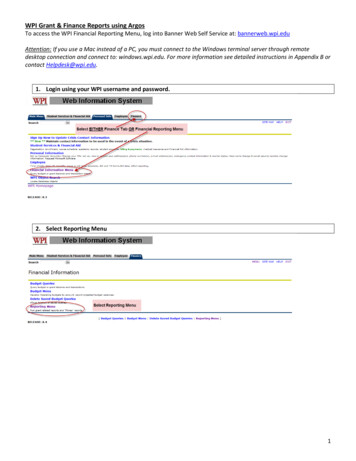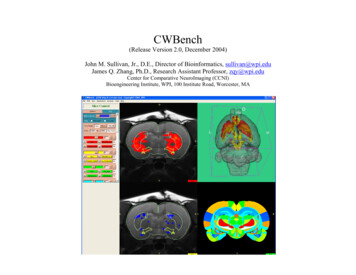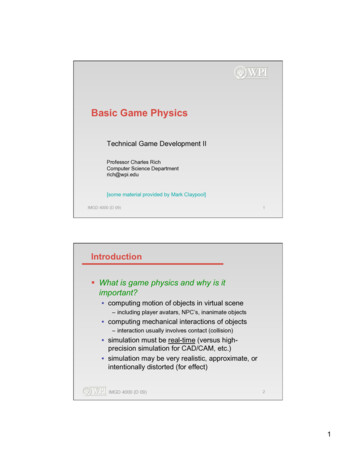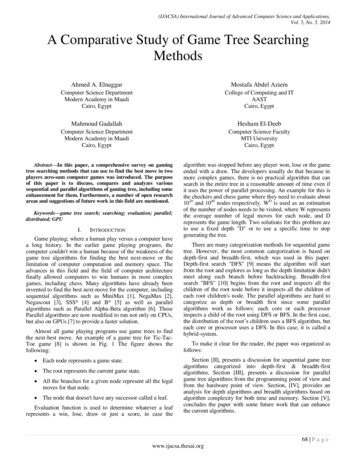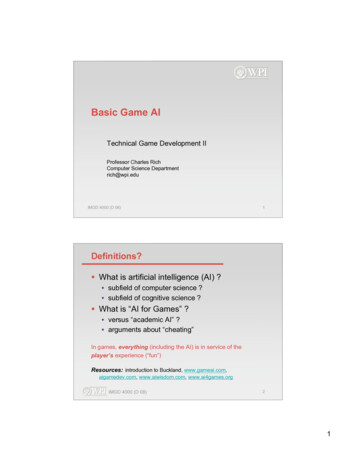
Transcription
Basic Game AITechnical Game Development IIProfessor Charles RichComputer Science Departmentrich@wpi.eduIMGD 4000 (D 08)1Definitions? What is artificial intelligence (AI) ? subfield of computer science ? subfield of cognitive science ? What is “AI for Games” ? versus “academic AI” ? arguments about “cheating”In games, everything (including the AI) is in service of theplayer’s experience (“fun”)Resources: introduction to Buckland, www.gameai.com,aigamedev.com, www.aiwisdom.com, www.ai4games.orgIMGD 4000 (D 08)21
What’s the AI part of a game? Everything that isn’t graphics (sound) ornetworking. or physics (though sometimes lumped in) usually via the non-player characters but sometimes operates more broadly, e.g.,– Civilization games– interactive storytellingIMGD 4000 (D 08)3“Levels” of Game AI Basic decision-making techniques commonly used inalmost all games Advanced used in practice, but in more sophisticated games Future not yet used, but explored in researchIMGD 4000 (D 08)42
This course Basic game AI (this week) decision-making techniques commonly used inalmost all games–––––decision trees(hierarchical) state machinesscriptingminimax searchpathfinding (beyond A*) Advanced game AI (weeks 5-6) used in practice, but in more sophisticated games– autonomous movement, steering (3 lectures)– goal-based AI in Halo 3 (2 lectures from GDC)IMGD 4000 (D 08)5Future Game AI ? Take IMGD 400X next year (B)“AI for Interactive Media and Games” fuzzy logic more goal-driven agent behavior Take CS 4341 “Artificial Intelligence” machine learning planningIMGD 4000 (D 08)63
Two Fundamental Types of AI Algorithms Search vs. Non-Search non-search: amount of computation is predictable(decision trees, state machines) search: upper bound depends on size of searchspace (often large)– scary for real-time games– need to otherwise limit computation (e.g., threshold) Where’s the “knowledge”? non-search: in the code logic (or external tables) search: in state evaluation and search orderfunctionsIMGD 4000 (D 08)7First Basic AI Technique:Decision TreesReference: Millington, Section 5.24
Decision Trees The most basic of the basic AI techniques Easy to implement Fast execution Simple to understand9IMGD 4000 (D 08)Deciding how to respond to an enemyif (visible) {if (close) {attack;} else {if (flank) {move;} else {attack;}}} else {if (audible) {creep;}}IMGD 4000 (D pnoattackyesattackmove105
Which would you rather modify?if (visible) {if (visible) {if (close) {if (close) {attack;attack;} else {} else if (flank) {if (flank) {move;move;} else {} else {attack;attack;}}} else if (audible) {}creep;} else {}if (audible) epattackflank?noyesattackmove11IMGD 4000 (D 08)Designing OO Decision Trees(see Millington, Section 5.2.3)class Nodedef decide()class Action : Nodedef decide()return thisclass Decision : NodeyesNodenoNodetestValueclass MinMax : DecisionminValuemaxValuedef getBranch()if maxValue testValue minValuereturn yesNodeelsereturn noNodedef getBranch()def decide()return getBranch().decide()IMGD 4000 (D 08)126
Building and Maintaining a Decision Treevisibleaudibleclose flank decision[0] decision[1]decision[2] decision[3] new Boolean. new Boolean.new MinMax.new Boolean.attack action[0] new Move.move action[1] new Move.creep action[2] new sNode closevisible.noNode audibleyesflank?creepaudible.yesNode creepclose.yesNode attackclose.noNode flanknoyesattackattackmoveflank.yesNode moveflank.noNode attack.or a graphical editorIMGD 4000 (D 08)13Performance Issues individual node tests (getBranch) typicallyconstant time (and fast) worst case behavior depends on depth of tree longest path from root to action roughly “balance” tree (when possible) not too deep, not too wide make commonly used paths shorter put most expensive decisions lateIMGD 4000 (D 08)147
Next Basic AI Technique:(Hierarchical) State MachinesReferences: Buckland, Chapter 2Millington, Section 5.3State Machineson guardsmall enemylarge enemyescapedfightlosing fightrun awayIMGD 4000 (D 08)168
Hard-Coded Implementationclass Soldierenum StateGUARDFIGHTRUN AWAYcurrentStateon guardsmall enemylarge enemyescapedfightlosing fightrun awaydef update()if currentState GUARD {if (small enemy)currentState FIGHTstartFightingif (big enemy)currentState RUN AWAYstartRunningAway} else if currentState FIGHT {if (losing fight) ccurrentState RUN AWAYstartRunningAway} else if currentState RUN AWAY {if (escaped)currentState GUARDstartGuarding}IMGD 4000 (D 08)17Hard-Coded State Machines Easy to write (at the start) Very efficient Notoriously hard to maintain (e.g., debug)IMGD 4000 (D 08)189
Cleaner & More Flexible Implementationclass Stateclass StateMachine(see Millington, Section 5.3.3)def getAction()def GetEntryAction()statesdef getExitAction()initialStatedef getTransitions()currentState initialStateclass Transitiondef isTriggered()def getTargetState()def getAction()def update()triggeredTransition nullfor transition in currentState.getTransitions()if transition.isTriggered()triggeredTransition transitionbreakif triggeredTransitiontargetState triggeredTransition.getTargetState()actions currentState.getExitAction()actions triggeredTransition.getAction()actions targetState.getEntryAction().add tracingIMGD 4000 (D 08)currentState targetStatereturn actionselsereturn currentState.getAction()19Combining Decision Trees & State Machines Why? to avoid duplicating expensive testsplayer in sight AND faralarmalertplayer in sight AND nearIMGD 4000 (D 08)defend2010
Combining Decision Trees & State Machinesyesalarmplayer in sight?alertyesfar?nonodefend21IMGD 4000 (D 08)Hierarchical State Machines Why?searchsee trashgototrashhave trashtrash disposedIMGD 4000 (D 08)gotodisposal2211
Interruptions w powerrechargedsee trashsearchlow powergototrashhave trashtrash disposedgotodisposalrecharged6 - doubled the number of states!low powerrecharge(disposal)23IMGD 4000 (D 08)Add Another Interruption Typehide(search/recharge)all clearbattlehidehidehidehidehide12 - doubled the number of states again!IMGD 4000 (D 08)2412
Hierarchical State Machine leave any state in (composite) ‘clean’ state when ‘low power’ ‘clean’ remembers internal state and continues when returned to via ‘recharged’’cleanlow powerrechargesearchsee trashgototrashrechargedhave trashtrash disposedgotodisposal25IMGD 4000 (D 08)Add Another Interruption Type7 states (including composite) vs. 12hide(recharge)battleall clearcleanlow powerrechargesearchsee trashgototrashrechargedhave trashtrash disposedgotodisposalbattlehideall clearIMGD 4000 (D 08)(clean)2613
Cross-Hierarchy Transitions Why? suppose we want robot to top-off battery if itdoesn’t see any trashcleanlow powersearchsee trashgototrashrechargerechargedhave trashtrash disposedgotodisposal27IMGD 4000 (D 08)Cross-Hierarchy Transitionsless than 75% powercleanlow powerrechargesearchsee trashgototrashrechargedhave trashtrash disposedIMGD 4000 (D 08)gotodisposal2814
Implementation Sketchclass HierarchicalStateMachineclass State# stack of return statesdef getStates() return [this]# recursive updatedef update()# rest same as flat machineclass Transition# how deep this transition isdef getLevel()# same state variables as flat machine# complicated recursive algorithmdef update ()class SubMachine : State,HierarchicalStateMachinedef getStates()push [this] onto currentState.getStates()# rest same as flat machinestruct UpdateResult # returned from updatetransitionlevelactions # same as flat machineIMGD 4000 (D 08)(see Millington, Section 5.3.9)29Next Basic AI Technique:ScriptingReferences: Buckland, Chapter 6Millington, Section 5.915
AI ScriptingHas something to do with: scripting languages role of scripting in the game developmentprocessIMGD 4000 (D 08)31Scripting LanguagesYou can probably name a bunch of them: general purpose languages Tcl, Python, Perl, Javascript, Ruby, Lua, . tied to specific games/engines UnrealScript, QuakeC, HaloScript, LSL, .IMGD 4000 (D 08)3216
General Purpose Scripting LanguagesWhat makes a general purpose scripting languagedifferent from any other programming language? interpreted (byte code, virtual machine) faster development cycle safely executable in “sandbox” simpler syntax/semantics: untyped garbage-collected builtin associative data structures plays well with other languages e.g., LiveConnect, .NETIMGD 4000 (D 08)33General Purpose Scripting LanguagesBut when all is said and done, it looks prettymuch like “code” to me. e.g. Luafunction factorial(n)if n 0 thenreturn 1endreturn n * factorial(n - 1)endIMGD 4000 (D 08)3417
General Purpose Scripting LanguagesSo it must be about something else.Namely, the game development process: For the technical staff data-driven design (scripts viewed as data, notpart of codebase) script changes do not require game recompilation For the non-technical staff allows parallel development by designers allows end-user extensionIMGD 4000 (D 08)35General Purpose Scripting LanguagesBut to make this work, you need to successfullyaddress a number of issues: Where to put boundaries (APIs) betweenscripted and “hard-coded” parts of game Performance Flexible and powerful debugging tools even more necessary than with some conventional(e.g., typed) languages Is it really easy enough to use for designers!?IMGD 4000 (D 08)3618
Lua in Gamesper Wikipedia* Aleph One (an open-source enhancement of Marathon 2: Durandal) supports Lua, and it'sbeen used in a number of scenarios (including Excalibur and Eternal).* Blobby Volley, in which bots are written in Lua.* Company of Heroes, a WW2 RTS. Lua is used for the console, AI, single player scripting,win condition scripting and for storing unit attributes and configuration information.* Crysis, a first-person shooter & spiritual successor to Far Cry.* Dawn of War, uses Lua throughout the game.* Destroy All Humans! and Destroy All Humans! 2 both use Lua.* Escape from Monkey Island is coded in Lua instead of the SCUMM engine of the older titles.The historic "SCUMM Bar" is renovated and renamed to the "Lua Bar" as a reference.* Far Cry, a first-person shooter. Lua is used to script a substantial chunk of the game logic,manage game objects' (Entity system), configure the HUD and store other configurationinformation.* Garry's Mod and Fortress Forever, mods for Half-Life 2, use Lua scripting for tools and othersorts of things for full customization.* Grim Fandango and Escape from Monkey Island, both based on the GrimE engine, are twoof the first games which used Lua for significant purposes.IMGD 4000 (D 08)37Lua in Games (cont’d)* Gusanos (Version 0.9) supports Lua Scripting for making the whole game modable.* Homeworld 2 uses Lua scripting for in-game levels, AI, and as a Rules Engine for gamelogic.* Incredible Hulk: Ultimate Destruction uses Lua for all mission scripting* JKALua, A game modification for the game JK3: Jedi Academy.* Multi Theft Auto, a multi-player modification for the Grand Theft Auto video game series.The recent adaptation for the game Grand Theft Auto San Andreas uses Lua.* Painkiller* Ragnarok Online recently had a Lua implementation, allowing players to fully customize theartificial intelligence of their homunculus to their liking, provided that they have an Alchemistto summon one.* ROBLOX is an online Lego-like building game that uses Lua for all in-game scripting.* SimCity 4 uses Lua for some in-game scripts.* Singles: Flirt Up Your Life uses Lua for in-game scripts and object/character behavior.* Spring (computer game) is an advanced open-source RTS engine, which is able to use Luafor many things, including unit/mission scripting, AI writing as well as interface changes.* S.T.A.L.K.E.R.: Shadow of Chernobyl* Star Wars: Battlefront and Star Wars: Battlefront 2 both use Lua.IMGD 4000 (D 08)3819
Lua in Games (cont’d)* Star Wars: Empire at War uses Lua.* Supreme Commander allows you to edit almost all its aspects with Lua.* Toribash, a turn-based fighting game, supports Lua scripting.* Vendetta Online, a science fiction MMORPG, lets users use Lua to customize the userinterface, as well as create new commands and react to events triggered by the game.* Warhammer Online uses Lua.* The Witcher.* World of Warcraft, a fantasy MMORPG. Lua is used to allow users to customize its userinterface.* Xmoto, a free and open source 2D motocross platform game, supports Lua scripting inlevels.39IMGD 4000 (D 08)The Other Path. A custom scripting language tied to a specific game,which is just idiosyncratically “different” (e.g.,QuakeC) doesn’t have much to recommend it However, a game-specific scripting language that istruly natural for non-programmers can be veryeffective:if enemy health 500 && enemy distance our bigrangemove .fire .else.return(GalaxyHack)IMGD 4000 (D 08)4020
Custom Tools with Integrated Scripting“Designer UI” from Halo 3IMGD 4000 (D 08)41Next Basic AI Technique:Minimax SearchReference: Millington, Section 8.221
Minimax Search Minimax is at the heart of almost everycomputer board game Applies to games where: Players take turns Have perfect information– Chess, Checkers, Tactics But can work for games without perfectinformation or with chance Poker, Monopoly, Dice Can work in real-time (i.e., not turn based)with timer (iterative deepening, later)IMGD 4000 (D 08)43The Game Treee.g,. Tic-Tac-ToeNote: -just showing top part of tree-symmetrical positions removed (optimization example)IMGD 4000 (D 08)4422
The Game TreeLevel 0 (First Player)Level 1 (Second Player)Level 2 (First Player) Nodes in tree represent states e.g., board configurations, “positions” Arcs are decisions that take you to a next state e.g., “moves” Technically a directed acyclic graph may have joins but no cycles Levels called plies (plural of ply) players alternate levels (or rotate among 2 players)IMGD 4000 (D 08)45Naive Approach1. Exhaustively expand tree naive because tree may be too bige.g., chess– typical board position has 35 legal moves– for 40 move game, 3540 number atoms in universe2. Choose next move on a path that leads toyour winning assumes your opponent is going to cooperateand “let” you winon his turn, he most likely will choose the worstcase for you!IMGD 4000 (D 08)4623
Minimax Approach assume both/all players play to the best of theirability define a scoring method (see next) from the standpoint of a given player (let’s callhim “Max” ): choose move which takes you to the next state withhighest expected score (from your point of view) assuming the other player (let’s call her “Min-nie” )will on her move choose the next state with thelowest score (from your point of view)IMGD 4000 (D 08)47(Static) Evaluation Function assigns score to given state from point ofview of given player scores typically integers in centered range– e.g., [-100, 100] for TTT– e.g., [-1000, 1000] for chess extreme values reserved for win/lose– this is typically the easy case to evaluate– e.g., for first player in TTT, return 100 if board has threeX’s in a row or -100 if three O’s in a row– e.g., checkmate for chess what about non-terminal states?IMGD 4000 (D 08)4824
(Static) Evaluation Function much harder to score in middle of the game score should reflect “likelihood” a player will win fromgiven state (board position) but balance of winning/losing isn’t always clear (e.g.,number/value of pieces, etc.) e.g., in Reversi, best strategy is to have fewest counters inmiddle of game (better board control) generic “local maxima” problem with all “hill climbing” searchmethods static evaluation function is where (most) gamespecific knowledge resides49IMGD 4000 (D 08)Naive Approach1. Apply static evaluation to each next state2. Choose move to highest scoring stateIf static evaluation function were perfect, thenthis is all you need to do perfect static evaluator almost never existsusing this approach with imperfect evaluatorperforms very badlyThe solution?IMGD 4000 (D 08)Look ahead!5025
Minimax Looking Ahead5Max3453 945 6 7MinMaxIt’s Max’s turn at the start of the game (root of the tree)There is only time to expand tree to 2nd plyMax’s static evaluation function has been applied to all leaf statesMax would “like” to get to the the 9 point stateBut if chooses leftmost branch, Min will choose her move to get to 3 left branch has a value of 3 If Max chooses rightmost branch, Min can choose any one of 5,6 or 7 (will choose 5, the minimum) right branch has a value of 5 Right branch is largest (the maximum) so choose that move IMGD 4000 (D 08)51Minimax “Bubbling Up Values” Max’s turn (root of tree)Circles represent Max’s turn, Squares represent Min’s turnValues in leaves are result of applying static evaluation functionRed arrows represent best (local) move for each playerBlue arrow is Max’s chosen move on this turnIMGD 4000 (D 08)5226
Minimax Algorithmdef MinMax (board, player, depth, maxDepth)if ( board.isGameOver() or depth maxDepth )return board.evaluate(player), nullbestMove nullif ( board.currentPlayer() player )bestScore -INFINITYNote: makeMove returns copy of boardelse bestScore INFINITY(can also move/unmove--but don’t execute graphics!)for move in board.getMoves()newBoard board.makeMove(move)score, move MinMax(newBoard, player, depth 1, maxDepth)if ( board.currentPlayer() player )if ( score bestScore ) # maxbestScore scorebestMove moveNote: test works for multiplayerelsecase alsoif ( score bestScore ) # minbestScore scorebestMove movereturn bestScore, bestMoveMinMax(board, player, 0, maxDepth)IMGD 4000 (D 08)53Negamax Version for common case of two player zero sum single static evaluation function returns or - same value for given board position,depending on playerIMGD 4000 (D 08)5427
Negamax Algorithmdef NegaMax (board, depth, maxDepth)if ( board.isGameOver() or depth maxDepth )return board.evaluate(), nullbestMove nullbestScore -INFINITYfor move in board.getMoves()newBoard board.makeMove(move)score, move NegaMax(newBoard, depth 1, maxDepth)score -scoreif ( score bestScore )bestScore scorebestMove movereturn bestScore, bestMoveNegaMax(board, 0, maxDepth)IMGD 4000 (D 08)55Pruning Approach Minimax searches entire tree, even if in some cases itis clear that parts of the tree can be ignored (pruned) Example: You won a bet with your enemy.He owes you one thing from a collection of bags.You get to choose the bag, but your enemy chooses the thing.Go through the bags one item at a time.–––––First bag: Sox tickets, sandwich, 20He’ll choose sandwichSecond bag: Dead fish, He’ll choose fish.Doesn’t matter what the rest of the items in this bag are ( 500,Yankee’s tickets )– No point in looking further in this bag, since enemy’s dead fish isalready worse than sandwichIMGD 4000 (D 08)5628
Pruning Approach In general, Stop processing branches at a node when you findfind a branch worse than result you already know youcan achieve This type of pruning saves processing time withoutaffecting final result i.e., not a “heuristic” like the evaluation function in A*IMGD 4000 (D 08)57Pruning Example From Max’s point of view, 1 is already lower than 4, which heknows he can achieve, so there is no need to look farther atsibling branches Note that there might be large subtrees below nodes labeled2 and 3 (only showing the top part of tree)IMGD 4000 (D 08)5829
Alpha-Beta Pruning Keep track of two scores: Alpha – best score by any means– Anything less than this is no use (can be pruned) since we canalready get alpha– Minimum score Max will get– Initially, negative infinity Beta – worst-case scenario for opponent– Anything higher than this won’t be used by opponent– Maximum score Min will get– Initially, infinity As recursion progresses, the "window" of Alpha-Betabecomes smaller (Beta Alpha) current position not result of best play andcan be prunedIMGD 4000 (D 08)59Alpha-Beta NegaMax Algorithmdef ABNegaMax (board, depth, maxDepth, alpha, beta)if ( board.isGameOver() or depth maxDepth )return board.evaluate(player), nullbestMove nullbestScore -INFINITYfor move in board.getMoves()newBoard board.makeMove(move)score, move ABNegaMax(newBoard, maxDepth, depth 1,-beta,-max(alpha, bestScore))score -scoreif ( score bestScore )bestScore scorebestMove move# early loop exit (pruning)if ( bestScore beta ) return bestScore, bestMovereturn bestScore, bestMoveABNegaMax(board, player, maxDepth, 0, -INFINITY, INFINITY)IMGD 4000 (D 08)6030
Move Order Benefits of pruning depend heavily on orderin which branches (moves) are visited for example, if branches visited right to left aboveno pruning happens! for chess, on average reduce 35 branches - 6– allows search twice as deep!IMGD 4000 (D 08)61Move Order Can we improve branch (move) order? apply static evaluation function at intermediatenodes and check best first– logical idea– can improve pruning– but may effectively give up depth of search advantage (infixed time interval) due to high cost of function evalution better idea: use results of previous minimaxsearches– “negascout” algorithm (extra credit, see Millington 8.2.7)IMGD 4000 (D 08)6231
Chess Notes Chess has many forced tactical situations e.g., “exchanges” of pieces minimax may not find these add cheap check at end of turn to check forimmediate captures Library of openings and/or closings Use iterative deepening search 1-ply deep, check time, search 2nd ply, .IMGD 4000 (D 08)63Chess Notes Static evalution function typically use weighted function– c1*material c2*mobility c3*kingSafety . simplest is point value for material– pawn 1, knight 3, bishop 3, castle 3, queen 9 see references in homework instructions checkmate is worth more than rest combined what about a draw?– can be good (e.g., if opponent strong)– can be bad (e.g., if opponent weak)– adjust with “contempt factor” (above or below zero)IMGD 4000 (D 08)6432
Next Basic AI Technique:PathfindingReferences: Buckland, Chapter 5, 8Millington, Chapter 4A* Pathfinding Search Covered in IMGD 3000 Review below if neededReferences: Buckland, Chapter 5 (pp. 241-247)Millington, Section 4.3IMGD 4000 (D 08)6633
Practical Path Planning Just raw A* not enough Also need: navigation graphs– points of visibility (POV)– navmesh path smoothingcompute-time optimimzationshierarchical pathfindingspecial case methodsIMGD 4000 (D 08)67Navigation Graph Construction Tile (cell) based very common, esp. if env’t already designed insquares or hexagons each cell already labelled with material (mud, etc.) downside:– modest 100x100 cell map– 10,000 nodes and 78,000 edges– can burden CPU and memory, especially if multiple AI’scalling inRest of presentation is a survey about how todo better.IMGD 4000 (D 08)6834
Point of Visibility (POV) Navigation Graph Place graph nodes (usually by hand) atimportant points in env’t Such that each node has line of sight to atleast one other nodeIMGD 4000 (D 08)69NavMesh network of convex polygonsvery efficient to searchcan be automatically generated from polygonsbecoming very popularIMGD 4000 (D 08)7035
POV Navigation find closest visible node (a) to current locationfind closest visible node (b) to target locationsearch for least cost path from (a) to (b)move to (a)follow path to (b)move to target locationIMGD 4000 (D 08)71POV Navigation Obvious how to build and expand Downsides can take a lot of developer time, especially ifdesign is rapidly evolving problematic if random or user generated maps can have “blind spots” can have “jerky” paths Solutions automatically generate POV graph from polygons make finer grained graphs smooth pathsIMGD 4000 (D 08)7236
Automatic POV by Expanded Geometry1. expand geometry byamount proportionalto bounding radius ofagents2. add vertices to graph3. prune non line ofsight pointsIMGD 4000 (D 08)73Blind Spots in POV No POV point is visible from red spots! Easy to fix manually in small graphs A problem in larger graphsSolution: finely grained graphsIMGD 4000 (D 08)7437
Finely Grained Graphs Improves blind spots and path smoothness Typically generate automatically using “floodfill”IMGD 4000 (D 08)75Flood Fill same algorithm asin “paint” programsIMGD 4000 (D 08)7638
Path Finding in Finely Grained Graph use A* or Dijkstra depending on whetherlooking for one or multiple targetsIMGD 4000 (D 08)77Kinky PathsThe solution: Path smoothingIMGD 4000 (D 08)7839
Simple Smoothing Algorithm Check for “passability” between adjacent edgesIMGD 4000 (D 08)79Smoothing ExampleIMGD 4000 (D 08)8040
Methods to Reduce CPU Overheadtime/space tradeoffshortest path tablepath cost tableIMGD 4000 (D 08)81Hierarchical Path Planning reduces CPU overhead typically two levels, but can be more first plan in high-level, then refine in low-levelIMGD 4000 (D 08)8241
Getting Out of Sticky Situations bot gets “wedged” against wall looks really bad!IMGD 4000 (D 08)83Getting Out of Sticky Situations Heuristic: calculate the distance to bot’s current waypointeach update step if this value remains about the same orconsistently increases then it’s probably wedged backup and replanIMGD 4000 (D 08)8442
Pathfinding Summary You would not necessarily use all of thesetechniques in one game Only use whatever your game demands andno moreIMGD 4000 (D 08)85Basic Game AI Summary Decision-making techniques commonly usedin almost all games––––––decision trees(hierarchical) state machinesscriptingminimax searchpathfinding (beyond A*)References: Buckland 2, 5, 8; Millington 4, 5, 8 Advanced game AI (weeks 5-6) used in practice, but in more sophisticated games– autonomous movement, steering (3 lectures)– goal-based AI in Halo 3 (2 lectures from GDC)IMGD 4000 (D 08)8643
of the first games which used Lua for significant purposes. per Wikipedia IMGD 4000 (D 08) 38 Lua in Games (cont’d) * Gusanos (Version 0.9) supports Lua Scripting for making the whole game modable. * Homewo
